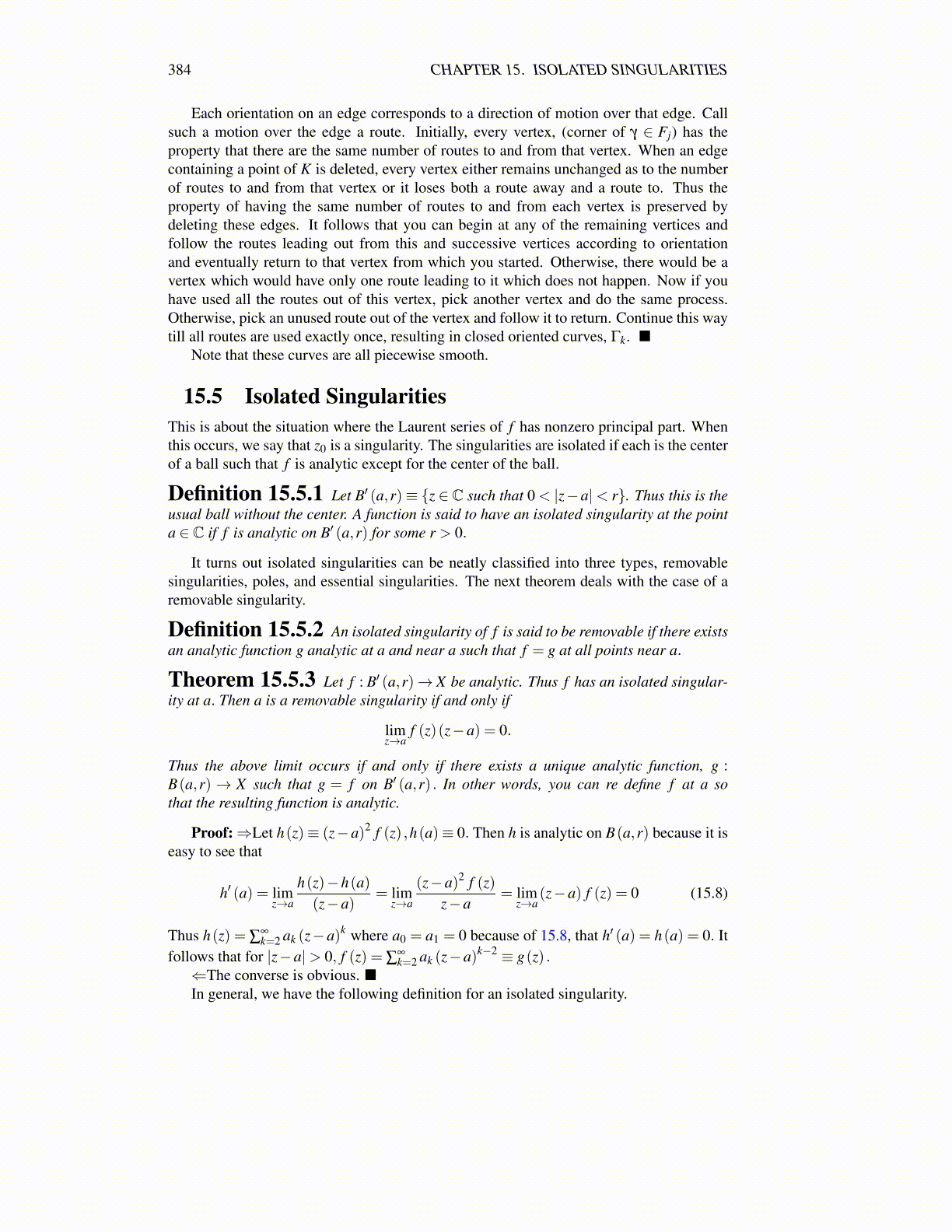
384 CHAPTER 15. ISOLATED SINGULARITIES
Each orientation on an edge corresponds to a direction of motion over that edge. Callsuch a motion over the edge a route. Initially, every vertex, (corner of γ ∈ Fj) has theproperty that there are the same number of routes to and from that vertex. When an edgecontaining a point of K is deleted, every vertex either remains unchanged as to the numberof routes to and from that vertex or it loses both a route away and a route to. Thus theproperty of having the same number of routes to and from each vertex is preserved bydeleting these edges. It follows that you can begin at any of the remaining vertices andfollow the routes leading out from this and successive vertices according to orientationand eventually return to that vertex from which you started. Otherwise, there would be avertex which would have only one route leading to it which does not happen. Now if youhave used all the routes out of this vertex, pick another vertex and do the same process.Otherwise, pick an unused route out of the vertex and follow it to return. Continue this waytill all routes are used exactly once, resulting in closed oriented curves, Γk. ■
Note that these curves are all piecewise smooth.
15.5 Isolated SingularitiesThis is about the situation where the Laurent series of f has nonzero principal part. Whenthis occurs, we say that z0 is a singularity. The singularities are isolated if each is the centerof a ball such that f is analytic except for the center of the ball.
Definition 15.5.1 Let B′ (a,r)≡ {z ∈ C such that 0 < |z−a|< r}. Thus this is theusual ball without the center. A function is said to have an isolated singularity at the pointa ∈ C if f is analytic on B′ (a,r) for some r > 0.
It turns out isolated singularities can be neatly classified into three types, removablesingularities, poles, and essential singularities. The next theorem deals with the case of aremovable singularity.
Definition 15.5.2 An isolated singularity of f is said to be removable if there existsan analytic function g analytic at a and near a such that f = g at all points near a.
Theorem 15.5.3 Let f : B′ (a,r)→ X be analytic. Thus f has an isolated singular-ity at a. Then a is a removable singularity if and only if
limz→a
f (z)(z−a) = 0.
Thus the above limit occurs if and only if there exists a unique analytic function, g :B(a,r) → X such that g = f on B′ (a,r) . In other words, you can re define f at a sothat the resulting function is analytic.
Proof:⇒Let h(z)≡ (z−a)2 f (z) ,h(a)≡ 0. Then h is analytic on B(a,r) because it iseasy to see that
h′ (a) = limz→a
h(z)−h(a)(z−a)
= limz→a
(z−a)2 f (z)z−a
= limz→a
(z−a) f (z) = 0 (15.8)
Thus h(z) = ∑∞k=2 ak (z−a)k where a0 = a1 = 0 because of 15.8, that h′ (a) = h(a) = 0. It
follows that for |z−a|> 0, f (z) = ∑∞k=2 ak (z−a)k−2 ≡ g(z) .
⇐The converse is obvious. ■In general, we have the following definition for an isolated singularity.